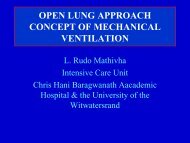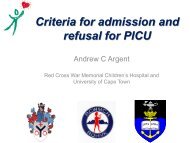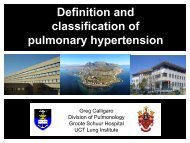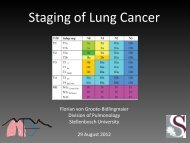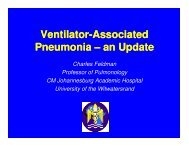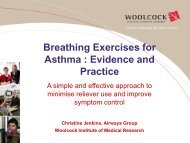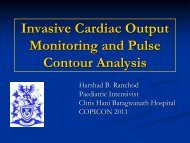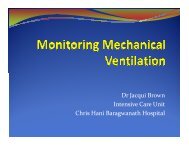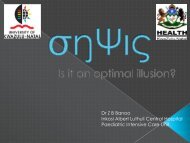The only ones who care about improving quality - Marlice van Dyk
The only ones who care about improving quality - Marlice van Dyk
The only ones who care about improving quality - Marlice van Dyk
You also want an ePaper? Increase the reach of your titles
YUMPU automatically turns print PDFs into web optimized ePapers that Google loves.
THE ONLY ONES WHO CARE<br />
ABOUT IMPROVING<br />
QUALITY CARE IN THE ICU<br />
ARE THE PATIENTS<br />
<strong>Marlice</strong> <strong>van</strong> <strong>Dyk</strong><br />
Unitas Hospital
HOW DOES THIS TRANSLATE TO QOC FOR<br />
THE PATIENT<br />
• Poly Trauma patient A<br />
• Doctor too busy to see patient immediately<br />
• EN looks after patient, doesn’t know that she must resus<br />
patient<br />
• Miss golden hour<br />
• Rhabdomyolysis
PATIENT A<br />
• Doctor prescribes but doesn’t check that orders are followed<br />
• Fluid overload patient
PATIENT A<br />
• Abdominal compartment syndrome<br />
• Acute renal failure<br />
• Does not adjust dose of drugs for the renal failure<br />
• Convulsions<br />
• Bone marrow depression from anticonvulsant therapy<br />
• Sepsis<br />
• ARDS<br />
• Prolonged injurious ventilation, sedation<br />
and muscle relaxation
PATIENT A<br />
• Acalculous cholesistitis<br />
• Surgery<br />
• Breakdown of anastomosis<br />
• Numerous courses of antibiotics<br />
• C. Diff<br />
• Malnutrition<br />
• ICU acquired weakness<br />
• Protracted, difficult ICU stay >3mnth<br />
• 1 year later<br />
• Physically weak<br />
• Retrenched<br />
• Major depression<br />
• Financially ruined
PATIENT B<br />
• ICU trained doctor awaits patient arrival in ICU<br />
• Immediate resuscitation, lines, prescription<br />
• Highly qualified, highly motivated ICU trained nurse following<br />
the prescription and protocols of the unit<br />
• ICU doctor see patient frequently during the resus period<br />
• Communications with all other specialists involved<br />
• Well-resussitated patient goes to theatre to have all his<br />
fractures attended to<br />
• Optimal fluid, pain and nutrition strategy post theatre<br />
• Early extubation with optimal pain and fluid control<br />
• Early ICU and hospital discharge<br />
• 1 year later: no problem
WHAT IS QUALITY<br />
• Defined as:<br />
• Degree to which a set of inherent characteristics fulfil<br />
requirements<br />
• Quality <strong>care</strong> is an organisation-wide approach to understanding<br />
precisely what customers need and consistently delivering<br />
accurate solutions within budget, on time and with the<br />
minimum loss to society.<br />
• Quality is <strong>about</strong> meeting the needs and expectations of<br />
customers - John Rilley
WIKIPEDIA<br />
• Quality in business, engineering and manufacturing has a<br />
pragmatic interpretation as the non-inferiority or superiority<br />
of something; it is also defined as fitness for purpose.<br />
• Quality is a perceptual, conditional and somewhat subjective<br />
attribute and may be understood differently by different<br />
people.<br />
• Consumers may focus on the specification <strong>quality</strong> of a<br />
product/service, or how it compares to competitors in the<br />
marketplace. Product/service was produced d correctly. Support<br />
personnel may measure <strong>quality</strong> in the degree that a product is<br />
reliable, maintainable, or sustainable.
QUALITY<br />
• <strong>The</strong>re are 5 aspects of <strong>quality</strong>:<br />
• Producing - providing something.<br />
• Checking - confirming that something has been done correctly.<br />
• Quality Control - controlling a process to ensure that the<br />
outcomes are predictable.<br />
• Quality Management – directing an organisation so that it<br />
optimises its performance through analysis and improvement.<br />
• Quality Assurance – obtaining confidence that a product or<br />
service will be satisfactory.
WHO ARE THE ROLE PLAYERS IN ICU<br />
• Patients<br />
• Nurses<br />
• ICU trained RN<br />
• RN<br />
• EN<br />
• Nursing assistants<br />
• Doctors<br />
• Non-ICU trained vs. ICU trained<br />
• Part-time vs. Full time<br />
• Funders<br />
• Private Hospital Groups<br />
• Public sector<br />
• Health Care System
PATIENTS<br />
• Patient disempowered<br />
• Nearest hospital<br />
• Doctor on call<br />
• Nurse on duty<br />
• HRQL assessments, 1 yr, 60% of pre-ICU functionality are<br />
regained<br />
• ICU acquired weakness<br />
• Long-term cognitive dysfunction<br />
• Psychiatric i problems: major depression, PTSD, anxiety disorders<br />
d<br />
• Post-Intensive Care Family<br />
• Long-term <strong>care</strong>givers<br />
• Financial burden<br />
• Emotional burden
THE NURSES<br />
• <strong>The</strong> highly trained, highly motivated ICU nurse<br />
• Too few ICU trained<br />
• Not worth their while to study more<br />
• Must look after all the non-trained nurses in ICU – burn-out<br />
• Find the standards of <strong>care</strong> unacceptable<br />
• 2:1 or even 3:1 patient <strong>care</strong> and shift leading<br />
• Overworked and Underpaid!<br />
• <strong>The</strong> qualified, very experienced nurse
NURSES<br />
• <strong>The</strong> not-interested-in-anything-but-pay-check (agency) nurse<br />
• <strong>The</strong> Enrolled Nurse<br />
• Knowledge and training inadequate<br />
• <strong>The</strong> nursing assistant<br />
• What is he/she doing in ICU!<br />
• Outcome<br />
• Drug administration errors<br />
• Basic nursing <strong>care</strong> not done
NURSES<br />
Time Knowledge Interest<br />
ICU trained nurse X <br />
RN <br />
EN X <br />
Nursing assistant X <br />
Agency nurse <br />
• Producing - providing something.<br />
• Checking - confirming that something has been done correctly.<br />
• Quality Control - controlling a process to ensure that the outcomes are<br />
predictable.
DOCTORS<br />
• Time constrains<br />
• Too few doctors<br />
• Too many patients to see<br />
• Part-time ICU work<br />
• Spends 3 minutes / patient<br />
• No time to change the CVP even with new sepsis
• Perverse incentives<br />
• TPN<br />
• Ventilation<br />
• Brain dead patients<br />
• Terminal patients<br />
• Inadequate training<br />
• Injurious ventilation<br />
• Fluid overloaded patients<br />
• Nutrition!
DOCTORS<br />
• Non-existing ICU teams<br />
• No Team leader<br />
• No communication between doctors, or nurses and doctors<br />
• Money!
DOCTORS<br />
Time Knowledge Interest<br />
Non-ICU trained X X <br />
ICU trained <br />
Part time ICU X <br />
Full-time ICU <br />
• Producing - providing something.<br />
• Checking - confirming that something has been done correctly.<br />
• Quality Control - controlling a process to ensure that the outcomes are<br />
predictable.
THE FUNDERS<br />
• AMAF (Acute Medical Aid Failure)<br />
• Generics<br />
• Its cheap but does it work<br />
• Motivation for newer antibiotics<br />
• More expensive sedatives<br />
• <strong>The</strong> use of Precedex leads to on average a 19.2 points higher<br />
ACE (adapted cognitive exam) score than Propofol : ANIST trial<br />
• MRI/CT scans<br />
• Lab costs
THE PRIVATE HOSPITAL GROUPS<br />
• Closed vs. Open Units<br />
• Allows anyone to work in ICU (nurses and doctors)<br />
• EN cheaper than RN<br />
• Minimum staff<br />
• High patient: staff ratio
THE PRIVATE HOSPITAL GROUPS<br />
• ICU bed occupancy<br />
• <strong>The</strong> longer the patient stays the higher the bill<br />
• Inadequate equipment because they can’t bill for it<br />
• Beds<br />
• Exercise equipment<br />
• Dedicated NIV ventilators<br />
• CO monitors<br />
• Bronchoscopes<br />
• Capped fees<br />
• Drives costs down regardless
THE PRIVATE HOSPITAL GROUPS<br />
• Producing - providing something.<br />
• Sub-optimal service and equipment<br />
• Checking - confirming that something has been done correctly<br />
• No objective confirmation available<br />
• Quality Control - controlling a process to ensure that the<br />
outcomes are predictable.<br />
• Open vs. closed Units<br />
• Protocols and Guidelines
• Quality Management – directing an organisation so that it<br />
optimises its performance through analysis and improvement<br />
• LOS, Vent days, Mortality, Long-term outcome<br />
• Quality improvement programmes<br />
• Quality Assurance – obtaining confidence that a product or<br />
service will be satisfactory.<br />
• Data
PUBLIC SECTOR HOSPITALS<br />
• Closed Units<br />
• Dedicated ICU doctors<br />
• ICU trained nurses<br />
• Sometimes even good equipment<br />
• Poor Management!<br />
• No/poor lab service<br />
• No MRI/CT service<br />
• No continuity of <strong>care</strong><br />
• Communication!
PUBLIC SECTOR<br />
• Only generics<br />
• No empathy<br />
• No linen<br />
• Regular disposable and drug shortages because of nonpayment<br />
of providers<br />
• Inadequate number of beds for population
HEALTH CARE SYSTEM<br />
• Training of nurses – number and <strong>quality</strong><br />
• Training of doctors – number and <strong>quality</strong><br />
• Allowing anyone to work in ICU regardless of training, knowledge<br />
and experience<br />
• No data on disease profiles in general population that will need<br />
access to ICU<br />
• No data on number of ICU beds needed<br />
• No national business plan to address ICU shortages<br />
• No regional or national plan to address mismanagement of<br />
allocated budgets and improve payment of providers
WHAT IS THEIR AGENDA<br />
• Nurses<br />
• Do they have the knowledge, Interest, and time to <strong>care</strong><br />
• Just a pay check<br />
• Doctors<br />
• Do they <strong>care</strong><br />
• All <strong>about</strong> money<br />
• Funders<br />
• Money!<br />
• Hospital Groups<br />
• ICU is the most lucrative part of the hospital<br />
• Fill as many beds as possible at the lowest cost to the hospital<br />
• National Health <strong>care</strong><br />
• Training<br />
• Data analysis and system implementation
QUALITY CARE IN THE ICU<br />
• <strong>The</strong> devil is in the detail!<br />
• Every team member is vital<br />
• Knowledge, Interest and Time spend with the patient is vital<br />
to ensure Quality of Care<br />
• Do we fulfil the need of our patients<br />
Quality <strong>care</strong> is an organisation-wide approach to<br />
Q y g pp<br />
understanding precisely what customers need and<br />
consistently delivering accurate solutions within budget,<br />
on time and with the minimum loss to society.
QUESTIONS
WHY DO PATIENTS CARE ABOUT<br />
QUALITY<br />
• Acute Lung Injury/ARDS is an important health problem<br />
• Around 75 000 deaths/year in USA<br />
• Declining fatality rates around 1.1% 1% per year<br />
• More survivors but at significant cost of surviving with significant<br />
morbidity<br />
• Reduced exercise capability<br />
• Cognitive dysfunction<br />
• Significant cognitive sequelae<br />
• Depression<br />
• Anxiety disorder<br />
• PTSD<br />
• Pulmonary dysfunction is ‘minor’ morbidity as symptoms less<br />
likely from underlying lung pathology than from respiratory<br />
muscle weakness and diaphragmatic atrophy
EARLY MOBILIZATION<br />
• To prevent ICU acquired weakness<br />
• Early rehab programmes<br />
• Barriers: Patient<br />
• Cardiorespiratory instability<br />
• Raised intra cranial pressure<br />
• Level of cooperation<br />
• Pain<br />
• Delirium<br />
• Over sedation<br />
• Presence of catheters t and devices<br />
• Functional status (muscle strength, joint mobility, obesity,<br />
recent surgery)
EARLY MOBILIZATION<br />
• Barriers to early mobilization: health <strong>care</strong> providers<br />
• Absence of leadership in the team<br />
• Staffing levels<br />
• Team spirit<br />
• Equipment<br />
• Knowledge<br />
• Training<br />
• Referral
WHY DO PATIENTS CARE<br />
• Cognitive dysfunction after ICU may lead to the need for longterm<br />
<strong>care</strong> or assisted living facility post-ICU<br />
• <strong>The</strong>re is decreased <strong>quality</strong> of living and increased<br />
psychomotor symptoms in both the patient and the loved <strong>ones</strong>
• Post Intensive Care Family<br />
• 70% of family members present with symptoms of anxiety<br />
• 35% with depression<br />
• PTSD also common<br />
• 1 year post ICU loss: 40% present with criteria for psychiatric<br />
illness such as generalized anxiety, major depressive, or<br />
complicated grief<br />
• Prevention of post-ICU burden: communication i strategies
TEAM<br />
• Highly skilled team management<br />
• Leadership<br />
• Communication skills<br />
• Excellent communication between physicians and teams<br />
• Awareness of important clinical pitfalls<br />
• Constant vigilance (multiple cross-checks)<br />
• Centralized <strong>care</strong> planning
WHAT DOES THE PATIENT WANT<br />
• Closed Unit<br />
• ICU trained full time doctors<br />
• ICU trained, highly motivated nurses<br />
• Protocols or guidelines in place<br />
• Adequate equipment<br />
• Funders that look at cost-effectiveness and not just<br />
at cost<br />
• ICU teams with team leaders<br />
• Long-term data for the specific unit to measure<br />
performance<br />
• Implementation of <strong>quality</strong> <strong>care</strong> programs
QUESTIONS



